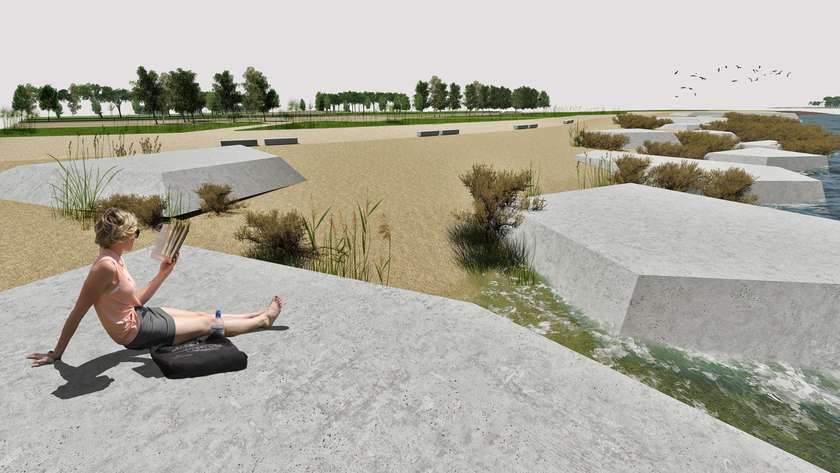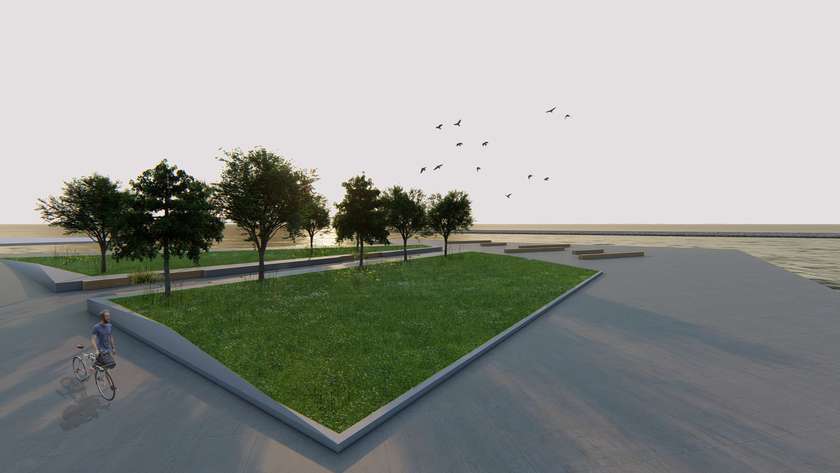Idea by
Xenia Mastoraki, Anna Ioannidou, Francesca Cocchiara, Angelika Kalash, Maria Moradi
LandmArch.
Call for ideas 2021
SITE-SPECIFIC REGENERATION OF PATRAS SEAFRONT BASED AGENDA 2030
SITE-SPECIFIC REGENERATION OF PATRAS SEAFRONT BASED AGENDA 2030

- Systemic changes
The project aims in having a broader impact in the local urban design, by promoting the application of participatory design and "placemaking" processes. Furthermore, its aim is to provide follow-up design solutions which are based on the main principles of Agenda 2030.
In other words, the goal is to cultivate a mindset where all stakeholders involved in the area’s urban development work together as a team. In that way, it will be possible to recover from the disfunctional decision-making practices of the past and their negative impact into public space.
The design proposal for the seafront of Patras is based on environmental, social, economic, technical and aesthetic criteria, in order to express a case-by-case thesis through site-specific strategies.
Finally, through the collaborative and creative process of placemaking, the emotional connections between residents and public space, as well as all provisions for its future maintenance and management, will be established.

Sandy beach with prismatic concrete breakwater elements.
This configuration facilitates transition between two different areas, one with an organic, semi-natural and one with a geometrical character. The form of these elements resembles to seismic cracks. Parts of the beach become flooded with water and create different configurations, depending on the occasional tide and rainfall.

Pines forest.
The seafront and the urban fabric are divided by a high-speed expressway. Therefore, dense tree clusters are proposed, in order to act as a buffer zone, offering sound, air and visual protection. The buffer zone consists of the existing eucalyptus forest and the addition of a pine forest includes areas of relaxation, recreation and socialization.

Geometric linear park.
The proposal for this part of the seafront has a strict geometric character and aims in concentrating the social life of the city on a large linear public space along the water. At the same time, the design of this area aims to preserve the memory of existing uses which are gradually abandoned, such as industrial and port uses, as well as the existing railway network, by redefining the linear railtrack traces.

The new Seafront of Patras.
The proposal is based on site-specific approaches, which follow the existing conditions, such as topography, land uses, social character, natural and built environment, traffic volume, views, population density, potential future activities and other parameters, in order to deliver a contemporary, sustainable and cohesive masterplan for the city’s water front.

Pine forest.
This section establishes the connection between the waterfront, the coast highway, the sidewalk, the linear rain gardens and the urban fabric’s coastal edge.
SITE-SPECIFIC REGENERATION OF PATRAS SEAFRONT BASED AGENDA 2030
SITE-SPECIFIC REGENERATION OF PATRAS SEAFRONT BASED AGENDA 2030

- Systemic changes
The project aims in having a broader impact in the local urban design, by promoting the application of participatory design and "placemaking" processes. Furthermore, its aim is to provide follow-up design solutions which are based on the main principles of Agenda 2030.
In other words, the goal is to cultivate a mindset where all stakeholders involved in the area’s urban development work together as a team. In that way, it will be possible to recover from the disfunctional decision-making practices of the past and their negative impact into public space.
The design proposal for the seafront of Patras is based on environmental, social, economic, technical and aesthetic criteria, in order to express a case-by-case thesis through site-specific strategies.
Finally, through the collaborative and creative process of placemaking, the emotional connections between residents and public space, as well as all provisions for its future maintenance and management, will be established.

Sandy beach with prismatic concrete breakwater elements.
This configuration facilitates transition between two different areas, one with an organic, semi-natural and one with a geometrical character. The form of these elements resembles to seismic cracks. Parts of the beach become flooded with water and create different configurations, depending on the occasional tide and rainfall.

Pines forest.
The seafront and the urban fabric are divided by a high-speed expressway. Therefore, dense tree clusters are proposed, in order to act as a buffer zone, offering sound, air and visual protection. The buffer zone consists of the existing eucalyptus forest and the addition of a pine forest includes areas of relaxation, recreation and socialization.

Geometric linear park.
The proposal for this part of the seafront has a strict geometric character and aims in concentrating the social life of the city on a large linear public space along the water. At the same time, the design of this area aims to preserve the memory of existing uses which are gradually abandoned, such as industrial and port uses, as well as the existing railway network, by redefining the linear railtrack traces.

The new Seafront of Patras.
The proposal is based on site-specific approaches, which follow the existing conditions, such as topography, land uses, social character, natural and built environment, traffic volume, views, population density, potential future activities and other parameters, in order to deliver a contemporary, sustainable and cohesive masterplan for the city’s water front.

Pine forest.
This section establishes the connection between the waterfront, the coast highway, the sidewalk, the linear rain gardens and the urban fabric’s coastal edge.